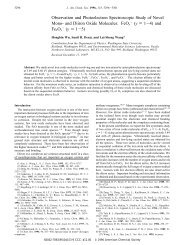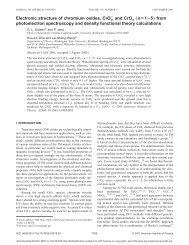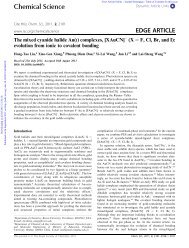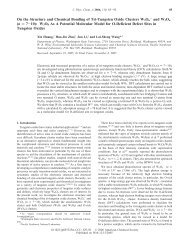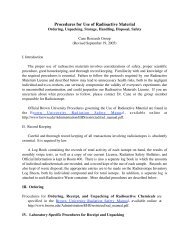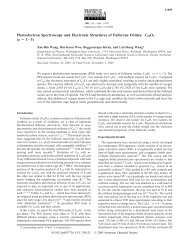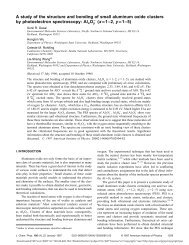Unique CO Chemisorption Properties of Gold Hexamer - Chemistry ...
Unique CO Chemisorption Properties of Gold Hexamer - Chemistry ...
Unique CO Chemisorption Properties of Gold Hexamer - Chemistry ...
You also want an ePaper? Increase the reach of your titles
YUMPU automatically turns print PDFs into web optimized ePapers that Google loves.
<strong>Unique</strong> <strong>CO</strong> <strong>Chemisorption</strong> <strong>Properties</strong> <strong>of</strong> <strong>Gold</strong> <strong>Hexamer</strong><br />
ARTICLES<br />
Figure 3. Optimized structures <strong>of</strong> the ground state and a low-lying isomer<br />
for Au 6(<strong>CO</strong>) 2 - and Au 6(<strong>CO</strong>) 2. All bond lengths are in Å, and all relative<br />
energies (in eV) are referenced to the anion ground state.<br />
Figure 2. Optimized structures <strong>of</strong> the ground state and a low-lying isomer<br />
for Au 6 - ,Au 6(<strong>CO</strong>) - , and their corresponding neutrals. All bond lengths<br />
are in Å, and all relative energies (in eV) are referenced to the anion ground<br />
state.<br />
Well-resolved PES spectra for Au 6 - were presented in our<br />
previous work. 34 The ADE and VDE <strong>of</strong> the ground-state X were<br />
measured to be 2.06 and 2.13 eV, respectively, where the ADE<br />
is in good agreement with a previous ZEKE measurement (2.05<br />
eV). 35 The VDE <strong>of</strong> band A at 4.43 eV defines an extremely<br />
large HOMO-LUMO gap <strong>of</strong> 2.30 eV for neutral Au 6 , which<br />
is the largest among all gold clusters. 34,35 Upon adsorption <strong>of</strong><br />
the first <strong>CO</strong>, the ground state feature X broadened (Figure 1b),<br />
but its binding energies (ADE: 2.04 eV; VDE: 2.20 eV) showed<br />
very little change relative to that <strong>of</strong> the bare cluster. This is<br />
completely different from the chemisorption behavior <strong>of</strong> the<br />
smaller gold clusters, where a red shift <strong>of</strong> as much as 0.6 to 0.7<br />
eV was observed upon the first <strong>CO</strong> chemisorption for Au n<br />
-<br />
(n ) 2-5). 32 However, the second VDE, corresponding to<br />
electron detachment from the anion ground state to the first<br />
neutral excited state (A), was measured to be 3.92 eV,<br />
significantly red-shifted by 0.51 eV with respect to that <strong>of</strong><br />
Au 6 - and resulting in a much smaller X-A energy gap (1.72<br />
eV).<br />
Upon further <strong>CO</strong> adsorption, the overall spectral patterns <strong>of</strong><br />
Au 6 (<strong>CO</strong>) 2 - (Figure 1c) and Au 6 (<strong>CO</strong>) 3 - (Figure 1d) appeared<br />
similar to that <strong>of</strong> Au 6 (<strong>CO</strong>) - : the first PES band X showed very<br />
little dependence on the number <strong>of</strong> <strong>CO</strong> ligands, whereas the<br />
higher binding energy features displayed continued red shifts,<br />
resulting in smaller and smaller X-A energy gaps: 1.45 eV<br />
for Au 6 (<strong>CO</strong>) 2 - and 1.17 eV for Au 6 (<strong>CO</strong>) 3 - . Very weak signals<br />
were observed in the X-A gap region in the spectra <strong>of</strong> the <strong>CO</strong><br />
chemisorbed species (Figure 1). These weak signals were likely<br />
due to minor structural isomers in the <strong>CO</strong>-chemisorbed complexes.<br />
Stronger signals were observed in the X-A gap region<br />
in the 266 nm spectra (Figures S2-S4). In fact, weak signals<br />
were also present in the 266 nm spectrum <strong>of</strong> the bare Au 6<br />
-<br />
(Figure S1b). These enhanced signals in the X-A gap region<br />
in the chemisorbed species at 266 nm were most likely due to<br />
autodetachment, which has been observed in other clusters with<br />
large HOMO-LUMO gaps, in particular for C 60 - and Au 20 - . 46,49<br />
4. Computational Results<br />
To find the <strong>CO</strong> chemisorption sites on the gold hexamer, we<br />
searched a variety <strong>of</strong> isomers for Au 6 (<strong>CO</strong>) n and Au 6 (<strong>CO</strong>) n - (n<br />
) 0-3). Optimized ground state and selected low-lying isomers<br />
for Au 6 (<strong>CO</strong>) n and Au 6 (<strong>CO</strong>) n - (1-18) are presented in Figures<br />
2-4. Optimized structures for other isomers and their relative<br />
energies are presented as Supporting Information in Figures S5-<br />
S7. The computed ADEs for the ground state and computed<br />
VDEs for the ground and first excited states <strong>of</strong> the lowest energy<br />
isomers are compared with the experimental data in Table 1.<br />
The computed VDEs for all the detachment channels up to the<br />
193 nm photon energy for the global minimum structures are<br />
given in Tables S1-S4. On the basis <strong>of</strong> these computed VDEs,<br />
we simulated the photoelectron spectra by convoluting each<br />
vertical detachment energy with a Gaussian function, as shown<br />
in Figure 5. In addition, the <strong>CO</strong> chemisorption energies were<br />
also computed, as compared with previous DFT results 27,28 in<br />
Table 3. Since we were only concerned with the trend <strong>of</strong> the<br />
adsorption energies, no zero-point energy corrections and basis<br />
set superposition error (BSSE) corrections were pursued.<br />
(49) Wang, X. B.; Ding, C. F.; Wang, L. S. J. Chem. Phys. 1999, 110, 8217.<br />
J. AM. CHEM. SOC. 9 VOL. 127, NO. 34, 2005 12101



